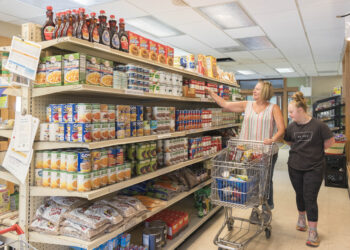SNO gained waste and carbon emission insights through “data-driven dumpster diving” into 7,709 pounds of Big Sky garbage.
By Jack Reaney STAFF WRITER
Nearly a quarter of Big Sky’s landfill waste is consumable food, troubling for a community that has seen food bank visitation skyrocket.
After months of dirty data collection, Big Sky Sustainability Network Organization (SNO) salvaged this startling food-use statistic among other treasures in the trash. The 2023 Big Sky Waste Composition Assessment is perhaps the first of its kind in Montana history, by digging into local garbage from 10 waste-audit samples between August 2022 and March 2023—more than 7,700 pounds of waste, sorted into 30 categories from four demographic sectors.
In Montana, the precedent for similar studies has been to model consumption on national data rather than sampling local garbage.
“Montana towns trend rural and geographically isolated. With no known data from live [waste] audits in Montana, modeling the waste stream based on distant cities doesn’t seem productive,” the report states.

A Big Sky SNO press release adds:
“The ultimate goal of all this ‘scientific dumpster diving’ was to gather baseline data about what is being sent to Logan Landfill in order to establish baseline data and eventually measure progress towards reducing waste, and ultimately, greenhouse gas emissions, as outlined in Big Sky’s Climate Action Plan.”
Lizzie Peyton, director of community sustainability with Big Sky SNO, wrote to EBS that solid waste accounted for 3.4% of Big Sky’s carbon emissions in 2018—a small slice, it’s still one of the Targeted Improvement Priorities detailed in the CAP.
“The concept of a ‘recycling economy or circular economy’ helps to explain [how reducing waste can reduce emissions]: when an item is ‘thrown away’ and heads to the landfill, all the energy, resources, and money that went into producing, processing, packaging, and transporting it end their purpose, too,” Peyton wrote.
Aluminum can be recycled using less than 5% of the energy used to make the original product, she added. A circular economy captures “waste” as a manufacturing resource.
Numbers show room to improve
On food, the study found that Big Sky’s “tremendous” total food waste—including inedible scraps like coffee grounds and fruit rinds—makes up 35.3% of all trash. More than a third of landfill waste could have been diverted to the existing commercial composting system, and Big Sky’s food waste by weight is 63% higher than the national average, according to the report.

The study also found that glass makes up 10.2% of Big Sky’s garbage, more than twice the national average—glass is not recycled in Big Sky due to the high cost of shipping it to Salt Lake City for processing, the release states.
Paper makes up 15.2% of garbage in Big Sky, despite being recyclable. Plastic makes up 12.5% of garbage and the report states that “plastics recycling is limited” at the Bozeman facility which processes Big Sky recycling. That facility, WeRecycleMT currently accepts: Mixed paper, white office paper, cardboard, Kraft paper, no. 1 plastic bottles, no. 2 plastic bottles and jugs, steel cans and aluminum cans.
There is currently one service that collects compost for homes and businesses: YES compost hauls food scraps and commercially compostable food service items (to-go containers, cups, etc.) to its facility in Belgrade.
Peyton wrote to EBS that as food composts, it releases “much less methane” than it would in a landfill.
“Sending uneaten food to the landfill squanders a whole litany of resources—seeds, water, energy, land, fertilizer, labor, financial capital—and generates greenhouse gases at every stage. When food ends up in landfills, it generates methane, an even more potent greenhouse gas than CO2 (25 times more potent),” Peyton explained.
The four demographic sectors studied were: single-family residences, multi-family residences, commercial institutions and vacation homes. All sectors showed similar results, all of which included wasted food, inedible food scraps and glass among the top five waste categories.
The report estimates that in 2022, Big Sky generated more than 6,515 tons of garbage, 672 tons of recycling, and 108 tons of compost—not including construction and demolition waste.
The resulting diversion rate of 10.7% is three times worse than the national average of 32.1%, according to the report.
“This study is a huge accomplishment for the Big Sky community, providing valuable data that will inform future waste management practices,” stated Alexis Alloway, a recycling educator for Republic Services, a Bozeman waste management company. “In addition to using a data-driven approach to waste management and emissions reductions, the WCA can also help estimate environmental and financial impacts of waste, as well as inform future infrastructure decisions.”
Community recommendations
The WCA report outlines recommendations to reduce greenhouse gas emissions in the Big Sky community.
The report outlines short-term improvements, including educating the community on waste reduction and recycling; increasing organic composting; developing and funding food rescue systems; and hosting community recycling days for specialty recycling items including glass, yard waste, scrap metals and electronic waste.
In the long term, the report recommends: creating a composting facility in Big Sky; reducing local glass consumption and finding outlets for reuse; examining options for creating a centralized decision-making authority that could create and enforce local ordinances.
“The rapid growth and development of Big Sky creates both challenges and opportunities for local citizens invested in the future of this unique place,” the report states.
The WCA was funded by the Big Sky Resort Area District (BSRAD), the Rieschel Foundation and Moonlight Community Foundation. In addition, essential labor was completed by Big Sky SNO, Republic Services, Gallatin Solid Waste Management District and the Gallatin County Sheriff Work Program.
“We are appreciative of all individuals and businesses that gave us permission to audit their waste, including larger organizations such as the Yellowstone Club, Moonlight Basin, Town Center Owners Association, and various [HOAs],” the report states.
Peyton wrote that as a tourism-based economy, it’s imperative “to educate consumers on how to repurpose, reuse & rethink their approach first, while also showing how to properly recycle & compost to divert from the landfill.”














